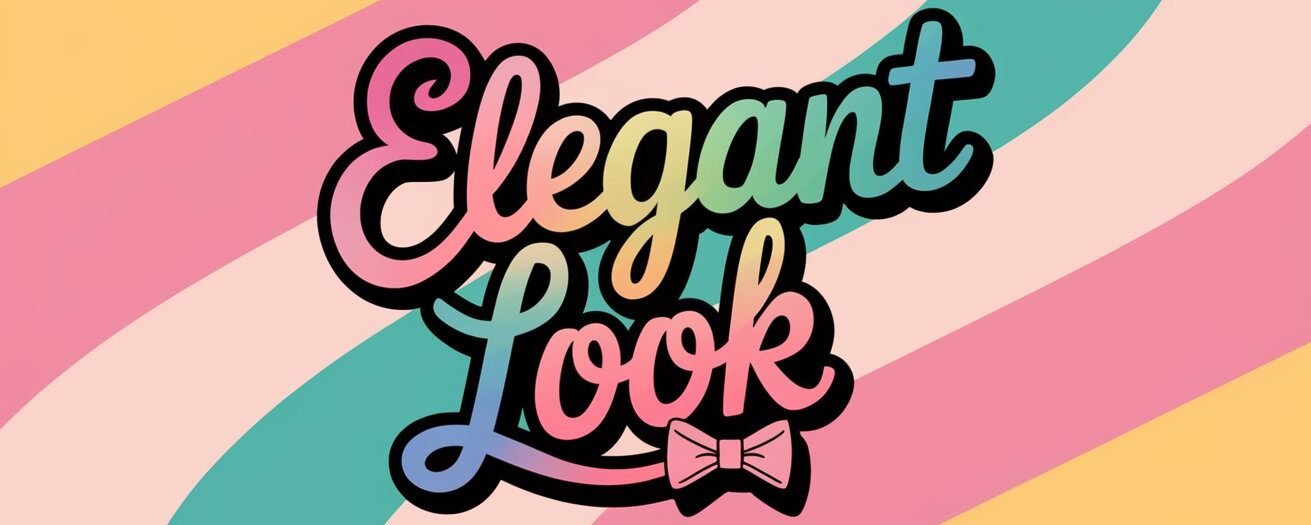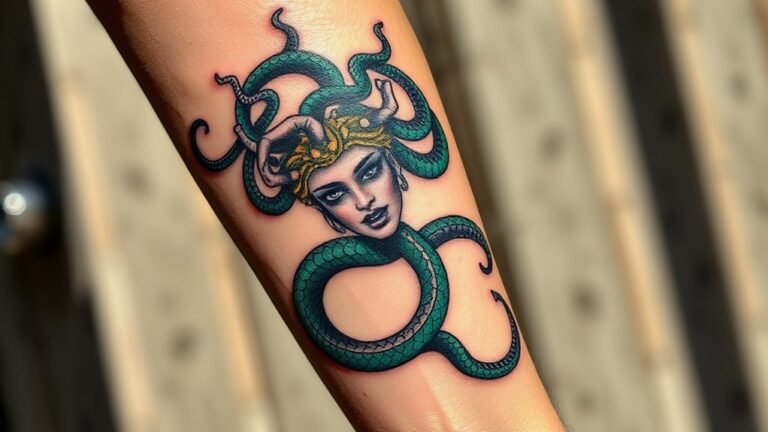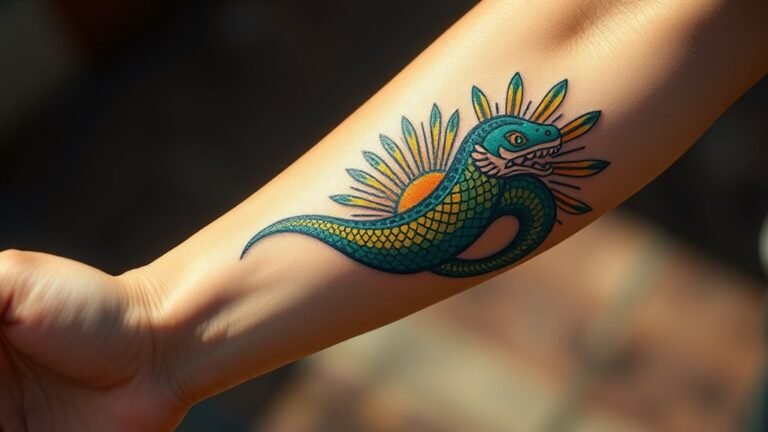Maori Tattoo Meaning and Symbolism
When you think about Māori tattoos, or Ta Moko, you might envision intricate patterns and deep cultural significance. Each design tells a story, reflecting not just personal identity but also ancestral heritage and social standing. For example, the koru symbolizes new beginnings, while the manaia offers a sense of protection. But what do these symbols reveal about the broader context of Māori culture and its evolving significance today? Understanding the layers of meaning behind Ta Moko can lead to a deeper appreciation of this art form and its role in contemporary society.
In a Nutshell
- Māori tattoos, or Ta Moko, symbolize cultural identity, ancestral heritage, and personal stories unique to each individual.
- Specific patterns like Koru and Manaia represent concepts such as growth and protection, respectively.
- Each tattoo design reflects social status, achievements, and connections to ancestry and community.
- Tattooing ceremonies foster community involvement, celebrating individual identity and cultural preservation.
- Modern interpretations blend traditional designs with contemporary aesthetics, enhancing appreciation for Māori tattoo art globally.
Historical Significance of Ta Moko
When you explore the historical significance of Ta Moko, you'll uncover a rich tapestry of cultural identity and ancestral heritage woven into the art of Māori tattooing.
This practice, steeped in historical context, showcases traditional techniques that have been passed down through generations. Each intricate design isn't just decorative; it reflects personal stories, tribal affiliations, and social status, serving as a living demonstration of the wearer's identity.
The use of tools like chisels, known as uhi, highlights the craftsmanship involved, transforming skin into a canvas of history.
Understanding Ta Moko allows you to appreciate its role in fostering a sense of belonging within the Māori community, connecting individuals to their ancestors and the land they cherish.
Common Maori Tattoo Designs
Ta Moko serves not only as a historical narrative but also as a vibrant expression of identity through its various designs.
You'll find that common Maori tattoo designs often incorporate traditional patterns, such as spirals, waves, and geometric shapes, each with its own significance. These designs connect you to your ancestry and community, reflecting a rich cultural heritage.
In recent years, contemporary influences have emerged, blending traditional elements with modern aesthetics, appealing to a broader audience. This fusion allows you to express your individuality while honoring the past.
Whether you choose a design steeped in history or one that modernizes these motifs, each tattoo tells a story, inviting you to belong to a living tradition that values both identity and artistry.
Symbolism Behind Specific Patterns
Each design in Maori tattooing carries deep symbolic meaning, often rooted in the natural world and ancestral stories. Understanding these patterns not only connects you to your heritage but also gives insight into the tattoo styles that define Maori culture.
Each design element holds significance, reflecting personal identity and communal values.
- Koru: Represents new beginnings and growth.
- Manaia: A guardian figure, symbolizing protection.
- Hei Tiki: Linked to fertility and the spirit of ancestors.
- Moko: Reflects social status and personal achievements.
- Raranga: Represents weaving connections among people.
These symbols weave together individual stories and collective histories, fostering a sense of belonging and unity within the Maori community.
Embracing these elements enriches your understanding of Maori culture.
Cultural Practices and Rituals
Understanding the symbolism behind Maori tattoo designs naturally leads to an appreciation of the cultural practices and rituals that surround their application.
Tattoo ceremonies, or "ta moko," are deeply significant events, often marked by communal participation. These rituals not only celebrate individual identity but also serve as essential acts of cultural preservation.
During the ceremony, the recipient undergoes a transformative experience, connecting with ancestral heritage and community values. You'll notice the meticulous attention to detail as skilled artists apply the ink, each stroke representing a story or lineage.
Engaging in these practices fosters a sense of belonging, reinforcing ties to Maori culture. By participating, you're honoring traditions that have thrived for generations, ensuring their continuation for future generations.
Modern Interpretations and Trends
As contemporary society evolves, so do the interpretations and expressions of Maori tattoo art, reflecting a dynamic interplay between tradition and modern identity.
You'll notice that modern aesthetics blend seamlessly with traditional designs, thanks to advancements in tattoo technology. This fusion creates unique pieces that resonate with individual stories while honoring cultural heritage.
- Increased accessibility to tattoo art
- Diverse representations of personal identity
- The rise of Maori-inspired designs in mainstream culture
- A growing appreciation for authenticity and cultural significance
- Influences from global tattoo trends
Through these trends, you're invited to explore a deeper connection, allowing Maori tattoos to serve as a powerful symbol of belonging and self-expression in a rapidly changing world.
The Role of Ta Moko Today
Ta moko, the traditional Maori tattooing practice, plays an essential role in contemporary Maori identity, serving as both a personal and collective expression of culture.
Today, ta moko identity fosters a deep connection to ancestry and heritage, empowering individuals to reclaim their cultural roots. As you observe the intricate designs, you'll notice they often symbolize life experiences, values, and social status, acting as a visual narrative of one's journey.
This practice also contributes to cultural revitalization, as more Maori engage in ta moko, promoting awareness and appreciation of their traditions.
Frequently Asked Questions
Can Anyone Get a Maori Tattoo Regardless of Heritage?
You can get a Maori tattoo, but be mindful of cultural appropriation and tattoo ethics. Understanding the significance behind the designs helps you appreciate their meaning, fostering deeper connections and respect for the culture involved.
How Are Maori Tattoos Different From Other Cultural Tattoos?
Maori tattoos stand out due to their deep cultural significance and unique tattoo techniques. They often convey personal stories and heritage, offering a sense of belonging that transcends mere aesthetics, unlike many other cultural tattoos.
What Materials Are Traditionally Used for Maori Tattooing?
When exploring traditional Maori tattooing, you'll find artists using specific traditional tools, like chisels, and natural ink sources, such as soot or plant-based dyes, which create unique designs with deep cultural significance and connection.
Are There Any Health Risks Associated With Getting a Maori Tattoo?
When getting a tattoo, you should be aware of potential health risks. Ink allergies can cause reactions, while improper hygiene during the process increases infection risks. Always choose a reputable artist to minimize these concerns.
How Do Maori Tattoos Influence Personal Identity Today?
Maori tattoos influence your personal identity by serving as powerful tools for personal expression and cultural connection. They embody your heritage, fostering a sense of belonging while showcasing stories that resonate deeply within your community.







